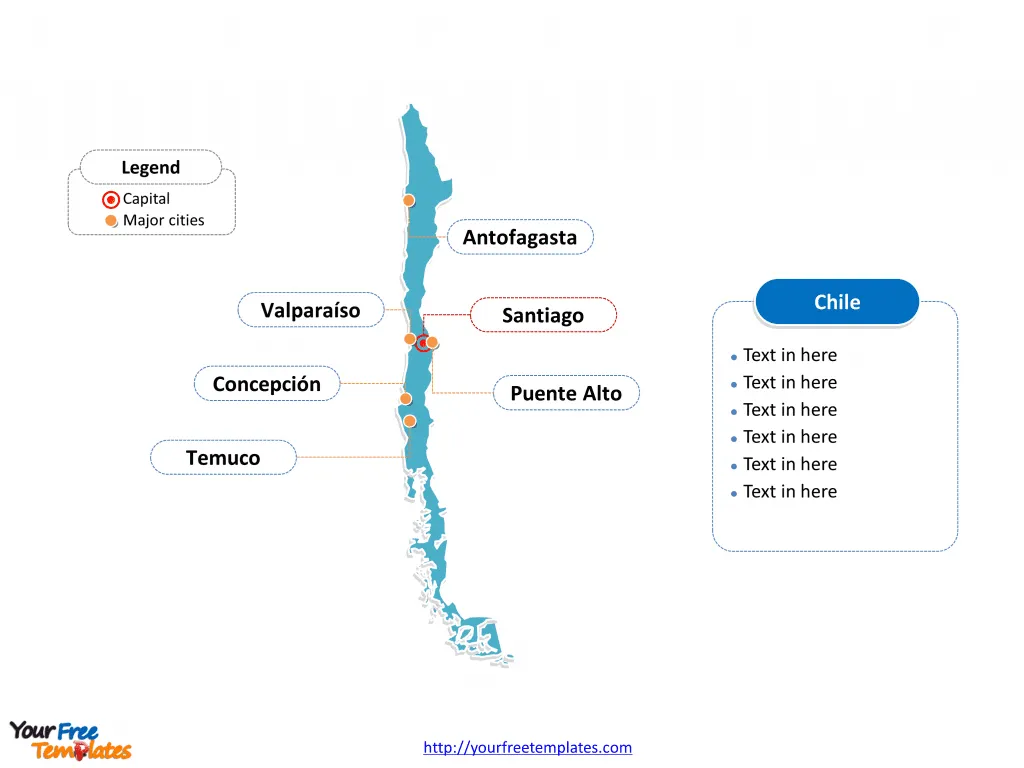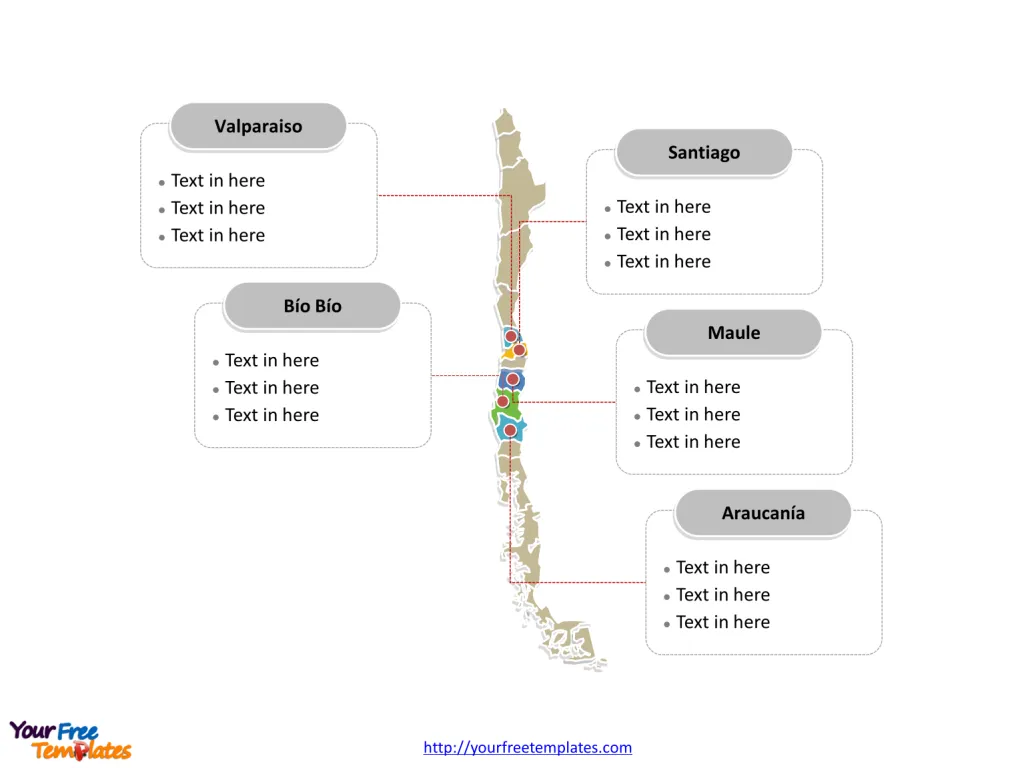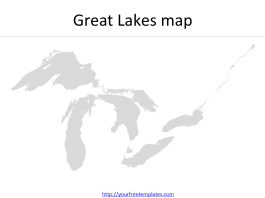The Chile Map Template includes two slides. Chile map with 15 regions, highlighting Araucanía, Biobío, Maule, Santiago, and Valparaiso regions. Chile map labeled with Santiago, Puente Alto, Antofagasta, Valparaíso, Concepción, and Temuco cities.
Chile is a long, narrow country stretching along the western edge of South America, with the Pacific Ocean to its west. It extends approximately 4,300 kilometers (2,670 miles) from its northern border with Peru to the southern tip of the continent, before curving eastward to comprise part of the Southern Cone.
Neighboring countries.To its east, Chile is bordered by Bolivia and Argentina across the rugged terrain of the Andes Mountains. Its unique geography, which includes deserts in the north, the fertile central valley, and the lakes and forests of the south, makes Chile a country of remarkable topographical diversity.
Slide 1, Chile map labeled with capital and major cities.
Chile, a long, narrow country stretching along South America’s western edge, is known for its remarkable diversity of landscapes, ranging from the arid Atacama Desert to the dense forests of the Andes. This geographical diversity is mirrored in its vibrant cities and distinct regions, each offering unique cultural, economic, and natural attractions.
Its capital and largest city is Santiago, other major cities including Puente Alto, Antofagasta, Valparaíso, Concepción, and Temuco.
Major Cities on Chile map
Santiago
As the capital and largest city, Santiago is the heart of Chilean culture, politics, and business. Nestled in a valley surrounded by the snow-capped Andes and the Chilean Coast Range, Santiago is a dynamic metropolis where colonial architecture meets modern skyscrapers. The city is a cultural hub, with numerous museums, theaters, and galleries, alongside bustling markets and a thriving culinary scene.
Puente Alto
Located just south of Santiago, Puente Alto is one of the largest cities in Chile. It serves as a crucial suburban hub, with a growing population and development. The city plays a significant role in the wine industry, contributing to the region’s reputation for fine wines.

Antofagasta
Positioned on the Pacific coast, Antofagasta is a vital port city known for its significant contribution to Chile’s mining industry, particularly copper and nitrate. The city is also a gateway to the stunning landscapes of the Atacama Desert, attracting tourists with interests in both industry and adventure.
Valparaíso
Famed for its bohemian culture, colorful hillside houses, and historic funiculars, Valparaíso is a UNESCO World Heritage site that offers a stark contrast to the country’s more modern cities. Its bustling port is one of the most important in the South Pacific, playing a critical role in international trade.
Concepción
Concepción, located in the Biobío Region, is an important industrial and commercial center, particularly known for its steel, machinery, and textile industries. The city is also a significant educational hub, home to several universities and cultural institutions.
Temuco
In the heart of the Araucanía Region, Temuco is a city deeply connected to the Mapuche culture. It serves as a commercial center for agricultural and livestock products and is a gateway to exploring the natural beauty of southern Chile, including national parks and volcanic landscapes.
Slide 2, Chile map labeled with major administration districts.
Chile is a country divided into 15 regions, Aisén, Antofagasta, Araucanía, Arica and Parinacota, Atacama, Biobío, Coquimbo, Los Lagos, Los Rios, Magallanes, Maule, O’Higgins, Santiago, Tarapaca, and Valparaiso.
The most populated provinces are Araucanía, Biobío, Maule, Santiago, and Valparaiso. Every individual political subdivision is an editable shape.
Major Regions on Chile map
Araucanía
Araucanía is a region characterized by its stunning natural landscapes, including lush forests, lakes, and volcanoes. It’s also the heartland of the Mapuche people, Chile’s largest indigenous group, making it a rich area for cultural exploration.

Biobío
The Biobío Region is an industrial powerhouse, known for its manufacturing sectors and hydroelectric power. It also boasts diverse natural attractions, from the Andes mountains to the Pacific coast.
Maule
Maule is primarily an agricultural region, celebrated for its vineyards and fruit production. It’s also home to historical sites and natural reserves, offering a blend of cultural and outdoor activities.
Santiago Region
The Santiago Metropolitan Region is not only the political and economic center of Chile but also a melting pot of Chilean culture and history. It offers everything from high-end shopping and dining to historical landmarks and parks.
Valparaíso Region
The Valparaíso Region is notable for its coastal cities, particularly the vibrant port city of Valparaíso. It’s a region of great natural beauty and cultural richness, offering a mix of beaches, vineyards, and historical sites.
In conclusion, Chile’s diversity is vividly reflected in its major cities and regions, each contributing unique flavors to the rich tapestry of the country. From the bustling streets of Santiago to the serene landscapes of Araucanía, Chile offers a wide range of experiences for every traveler.
Find out more about this country in United States Department of State.
Size: 96K
Type: PPTX
Aspect Ratio: Standard 4:3
Click the blue button to download it.
Download the 4:3 Template
Aspect Ratio: Widescreen 16:9
Click the green button to download it.
Download the 16:9 Template


